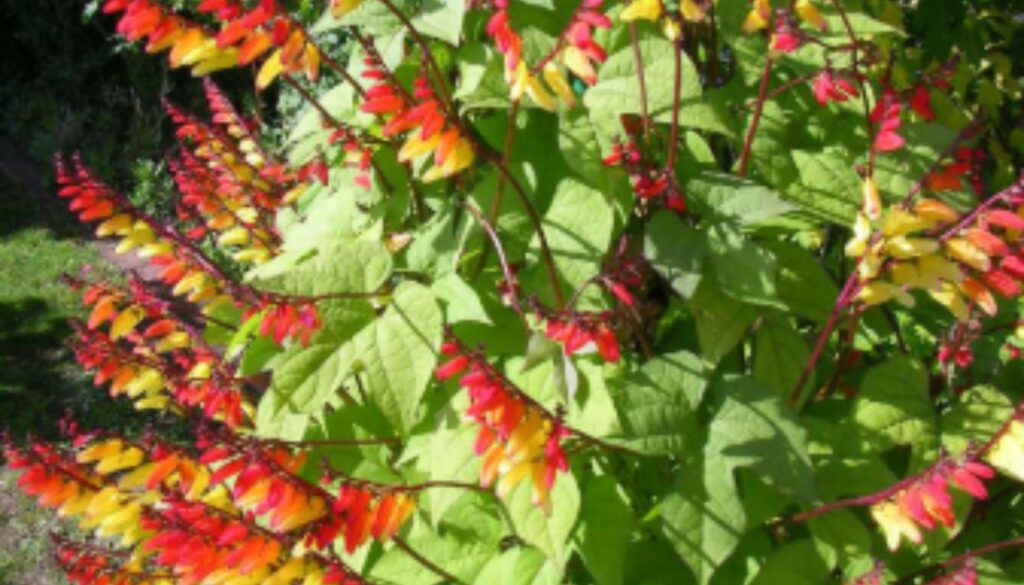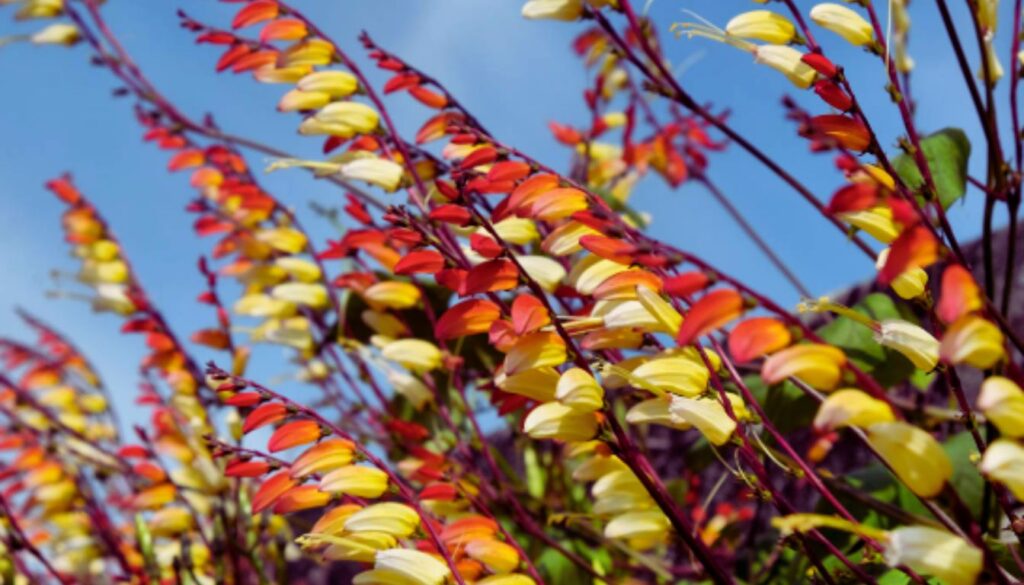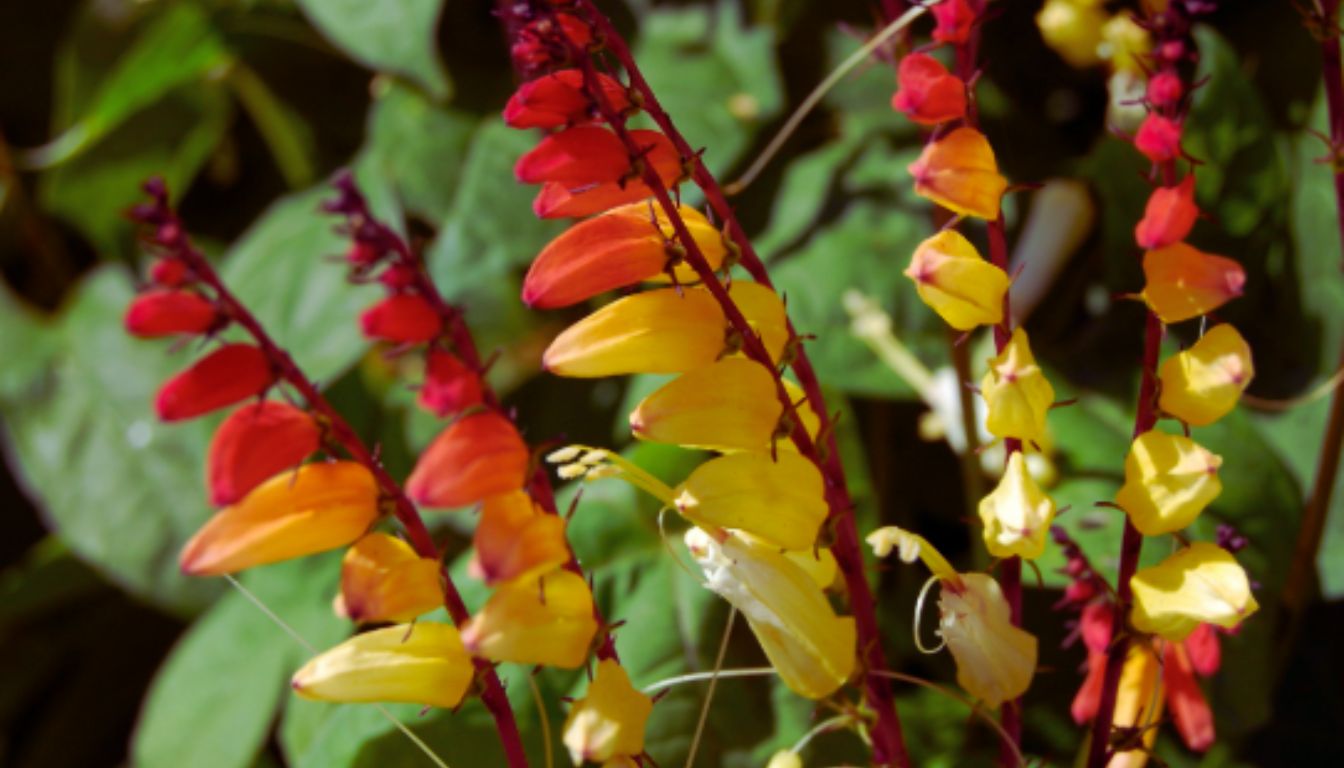If you’re looking to transform your garden into a vibrant oasis, let me introduce you to mina lobata. This stunning vine, often called Spanish flag, boasts a breathtaking display of colorful, trumpet-shaped flowers that can instantly elevate any outdoor space. With its rapid growth and unique beauty, mina lobata is not just a plant; it’s a statement.
Imagine lush greenery entwined with fiery red, yellow, and orange blooms, attracting pollinators and creating a lively atmosphere. Whether you’re a seasoned gardener or just starting out, incorporating mina lobata into your landscape can bring a touch of exotic flair. Join me as we explore the wonders of this remarkable plant and discover how to cultivate its beauty in your own backyard.
Overview of Mina Lobata
Mina lobata, commonly called Spanish flag, captivates with its vibrant colors and unique flower shape. This fast-growing vine attracts attention in any garden setting. Its trumpet-shaped flowers showcase a range of red, orange, and yellow hues. I find the visual impact to be quite stunning.
Growing mina lobata is straightforward. This plant thrives in well-drained soil and requires full sun for optimal blooming. I recommend planting it in a location where it can climb; trellises or fences work wonderfully. Watering regularly promotes healthy growth, but it’s best not to overwater. Too much moisture can harm the plant.
The blooms of mina lobata provide nectar, appealing to various pollinators like bees and hummingbirds. I enjoy watching these creatures visit my garden thanks to this plant. It not only enhances aesthetics but also supports local wildlife.
In terms of care, mina lobata is relatively low-maintenance. Trimming in late winter encourages bushier growth. Plus, this vine reaches heights of up to 10 feet, making it an excellent option for vertical gardening.
Consider mina lobata for a splash of color and effortless charm in your garden. Its ability to transform spaces is remarkable, and it fits well for those wanting an exotic touch without heavy upkeep.
Characteristics of Mina Lobata

Mina lobata, also known as the Spanish flag, showcases vibrant blooms that can brighten any garden. This eye-catching vine attracts attention with its colorful trumpet-shaped flowers.
Physical Appearance
I admire the way mina lobata displays its colorful flowers, ranging from deep red to bright orange and sunny yellow. The blooms take on a tubular shape, creating a beautiful gradient as they mature. Green heart-shaped leaves complement the flowers, adding lushness to any nearby structure. In full bloom, the plant can grow up to 10 feet tall, making it an excellent choice for vertical spaces. The vibrant flowers can draw in pollinators like bees and butterflies, transforming your garden into a lively scene.
Growth Requirements
Mina lobata craves full sun for best results. It thrives in well-drained soil that keeps moisture without becoming soggy. I find that planting it in a spot that gets at least six hours of sunlight daily works wonders. Water it regularly but avoid overwatering to prevent root rot. This vine enjoys growing along trellises or fences, and with a little love and care, it flourishes. Pruning back in late winter helps to maintain a bushier appearance, making it even more inviting in the warmer months.
Benefits of Mina Lobata
Mina lobata, commonly known as the Spanish flag, offers numerous benefits that enhance outdoor spaces and support the environment.
Aesthetic Appeal
Mina lobata turns any garden into a colorful masterpiece. Its trumpet-shaped flowers burst with shades of red, orange, and yellow. Each bloom creates a lovely gradient that draws the eye. The heart-shaped green leaves provide a lush backdrop, making the plant a stunning focal point. With its ability to climb up trellises and fences, this vine adds vertical interest. It’s like a painter’s palette coming to life. Planting it can make even the simplest space feel vibrant and inviting.
Environmental Impact
Mina lobata supports local wildlife, serving as a haven for pollinators such as bees and butterflies. These creatures thrive on its nectar, which helps sustain their populations. With proper care, I can cultivate a plant that not only beautifies my garden but also aids the ecosystem. Beyond the visual appeal, it encourages biodiversity, contributing to a healthier environment. Adding mina lobata isn’t just a choice for aesthetics; it’s an investment in nature’s balance.
Common Uses of Mina Lobata

Mina lobata serves several important functions in gardens and landscapes.
Landscaping
I love using mina lobata in landscaping projects. Its vibrant blooms add a splash of color to any outdoor space. I often plant it on trellises or fences to create stunning vertical displays. The flowers attract pollinators, which helps other plants thrive. Plus, the lush green leaves provide an appealing contrast. It’s perfect for adding life to dull areas. Mina lobata’s growth habit can soften hard edges and create a welcoming atmosphere.
Erosion Control
Mina lobata excels in erosion control. Its strong root system helps stabilize soil, preventing erosion on slopes or banks. Planting this vine in strategic locations provides a beautiful solution to a common problem. It’s a natural defense against soil loss. Besides protecting the soil, mina lobata’s dense growth offers a habitat for beneficial insects. I can count on it not just for beauty, but for a bit of environmental peace of mind.
Before You Go – Mina Lobata
Mina lobata truly stands out as a remarkable choice for anyone looking to enhance their garden’s beauty. Its vibrant colors and unique growth habit not only create a stunning visual impact but also support local wildlife. I love how this plant can transform any outdoor space into a lively oasis.
With minimal maintenance and the ability to thrive in various conditions, mina lobata makes gardening accessible for everyone. Whether you’re an experienced gardener or just starting out, incorporating this vine into your landscape is a decision you won’t regret. Embrace the charm of mina lobata and enjoy the benefits it brings to both your garden and the environment. Don’t forget to add The Herb Prof to your favorites so you don’t miss out on future articles.
References – Mina Lobata
Little Herb Encyclopedia, by Jack Ritchason; N.D., Woodland Publishing Incorporated, 1995
The Ultimate Healing System, Course Manual, Copyright 1985, Don Lepore
Planetary Herbology, Michael Tierra, C.A., N.D., Lotus Press, 1988
Handbook of Medicinal Herbs, by James A. Duke, Pub. CRP Second Edition 2007
The Complete Medicinal Herbal, by Penelope Ody, Published by Dorling Kindersley
Check the Following Articles
Top Flowers That Attract Butterflies: A Complete List
Devil’s Claw Adverse Effects: What You Need to Know
How to Espalier Tomatoes: Tips for a Thriving Garden
Simple Guide to Shimeji Mushroom Cultivation at Home
Frequently Asked Questions – Mina Lobata
What is mina lobata also known as?
Mina lobata is commonly referred to as the Spanish flag. This stunning vine is recognized for its vibrant, trumpet-shaped flowers that create a colorful display in gardens.
How does mina lobata grow?
Mina lobata is a fast-growing vine that thrives in well-drained soil and requires full sun for optimum blooming. It can reach heights of up to 10 feet, making it suitable for vertical gardening.
What soil conditions does mina lobata prefer?
Mina lobata prefers well-drained soil to flourish. Regular watering is essential, but avoid overwatering to prevent root rot.
How can mina lobata attract wildlife?
The vibrant blooms of mina lobata attract pollinators such as bees and butterflies. This supports local wildlife and enhances the garden’s overall ecosystem.
What are the benefits of growing mina lobata?
Growing mina lobata not only beautifies gardens with its colorful flowers but also contributes to erosion control and supports biodiversity, making it a valuable landscape choice.
How should I care for mina lobata?
Care for mina lobata includes regular watering without overwatering, planting it where it can climb, and trimming in late winter for bushier growth. These practices enhance its beauty and health.

